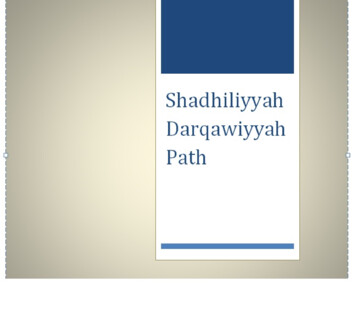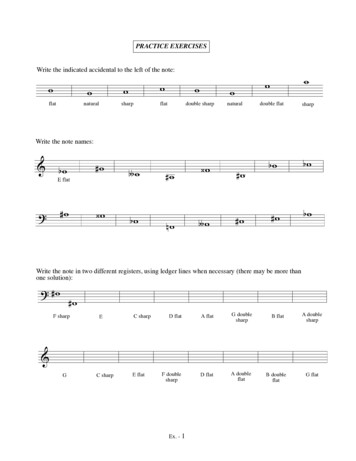
Transcription
Shadhiliyyah Darqawiyyah PathNotes and TextBased on forum http://sufi.forumup.co.uk/29th June 2006The Golden Chain of the Shadhiliyyah.3The Spiritual Succession Abu Madyan .3Muhyid-din Ibn Arabi learns about Abu Madyan .4Abu'l-Hasan ash-Shadhili.4Abdas-Salam ibn Mashish.4Shaykh Jazuli -author of Dalail al Khayrat .5As-saqalli.6Shaykh Ahmad at-Tijani .6Shaykh al-'Arabi ad-Darqawi .6Shaykh Ahmed Al-alawi .8The Life of the Shaikh Ahmad Al-Alawi By Himself Translation & commentary .8Shaykh Abdu 's-Salam ibn Mashish , the Shaykh of Shaykh Abul Hassan Shadhili .8The Ghawth Shaykh Abul Hasan al-Shadhili.19Abu al-Hasan ash-Shadhdhuli .32The Way of the Shadhili.44Our Shaykh says concerning the Way: .48Diagam Muraqbah Shadhaili Way.51Diagams & Text Muraqbah Shadhaili Way .52Contemplation in the Light of Remembrance al-Muraqabah fi Nuri-dh-Dhikr .53The Method of Practising Muraqabah .54Rooting the Two Names Tathbitul-'ismayin .56Read threes time before entering into Muraqabah and each evening before sleep: see next page.58Read threes time before entering into Muraqabah and each evening before sleep: see next page.59The Mystical Teachings of al-Shadhili from Ibn al-Sabbagh's Durrat al-Asrar wa Tufat al-Abarar .64translation by Elmer H. DouglaS Hizb ul Bahr - Litany of the Sea .64The Sufi Path is a process Dhikr ( remembrance ) - Alastu bi-Rabbikum? .69Knowledge of God by Shaykh Ahmad Ibn Mustafa al-‘Alawi .70The Introduction to al-Mawadd al-Ghaythiyyah by Shaykh al-Alawi of Mostaghanem .75This is Shaykh al-Alawi's introduction to his commentary on the Hikam of Abu Madyan al-Ghawth .75Al-Ism al-Mufrad On Permissibility of Using the Unique Name of Allah in Dhikr .86Foundations of the Spiritual Path (Source: Seasons Journal ).94By Sidi Ahmad Zarruq Translated by Shaykh Hamza Yusuf .94This has resulted in five other afflictions:.96The qualifications of the spiritual guide with whom the seeker may safely entrust his self are thefollowing five: .97The counsel of imam nawawi.98The counsel of sidi ahmad zarruq .99From al-qawaa’id Our Shaykh Abul ‘Abbaas al-Hadrami said: .102Some principles in al-Qawa'id by Zarruq.104Kitab at-Tahir: Formulation of the Principles of Political Insight.105by Muhammad Bello ibn Shaykh ibn Fodio .105The Basic Research : by Shaykh Ahmad ibn 'Ajiba (Qutb)-Darqawiyyah: Basic Research .118Shaykh Ahmad ibn 'Ajiba (Qutb)-Darqawiyyah: Basic Research.123The seventh rule concerning travel and visiting Shaykhs .1231. The first is that they travel to visit the Shaykhs.1262. The second reason for travel is to visit the brothers. .1273. The third reason the sufis travel is to acquire beneficial knowledge .1281
4. The fourth reason that the sufis travel is to acquire the hadith of the Prophet may Allah bless him andgive him peace .1285. The fifth reason to travel for the sufis is to stop wrong action. .1286. The sixth reason that the sufis travel is contemplation .1297. The seventh reason that the sufi travels is for the purpose of burying himself in obscurity or to negatereputation.1298. The eighth reason for which the sufis travel is to negate reputation.1299. The ninth reason for which the sufis travel is to visit the Prophet, may Allah bless him and give himpeace. This is one of the great nearnesses and the highest degrees .12910. The tenth reason the sufis travel is to visit the House of Allah and to stand on 'Arafat, and this is anobligation for whoever can, and is desirable for the others, once they have performed the otherobligations. .130Ibn Ajibah on the Hadhrah .137Excerpts from "Openings from Allah" by Shaykh Ahmad ibn Ajiba, a commentary on the AndalusianSufic text, "The Basic Research". .138Ahmad Ibn Ajiba:Regarding Our Supports on the Sufi Way up to the Prophet (Pbuh).141Ahmad Ibn Ajiba:On Our Passing to Esoteric Knowledge.142Ahmad Ibn Ajiba: On The States And Trials On The Way To Deliverance .142Haqīqah aţ-Ţay The Reality of Scrolling A Summary from the Iqādh of Ibn ‘Ajībah (ra) .143Ramadan Discourse Shaykh Muhammad ibn al-Habib .145Ramadan Discourse 2 Shaykh Muhammad ibn al-Habib .151Ramadan Discourse 3 Shaykh Muhammad ibn al-Habib .158Letter from Shaykh Muhammad ibn al-Habib .163Preface to the Diwan of Shaykh Ibn al-Habib.165Introduction To The Diwan Of Shaykh Muhammad Ibn Al-Habib .168MIFTAH AL-WIRD* The Key to the Source (The Wird of Shaykh Muhammad ibn al-Habib).173MIFTAH AL-WIRD .173The Lesser Wird.178THE SEAL OF THE WIRD.179Selections from the The Darqawi Way (letters of Shaykh Mawlay al-'Arabi al-Darqawi) .181Selections from The Letters of Shaykh ad-Darqawi.181Letters of Shaykh Mawlay al-'Arabi ad-Darqawi (to the fuqara).189-The Darqawi Way; The Letters of Shaykh Mawlay al-'Arabi ad-Darqawi .191The Path.191Selections from The Letters of Shaykh Mawlay al-'Arabi ad-Darqawi.193Selections from The Letters of Shaykh Mawlay al-'Arabi ad-Darqawi.194Selections from The Letters of Shaykh Mawlay al-'Arabi ad-Darqawi.194Letters of Shaykh Mawlay al-'Arabi ad-Darqawi (to the fuqara).194-The Darqawi Way; The Letters of Shaykh Mawlay al-'Arabi ad-Darqawi .196Be Content with the Opposites of your Desires .196-The Darqawi Way; The Letters of Shaykh Mawlay al-'Arabi ad-Darqawi .197Abandoning the Rest.197The Darqawi Way; The Letters of Shaykh Mawlay al-'Arabi ad-Darqawi .197First Letter from Shaykh Ahmad al-Badawi .197Shaykh Ahmad al-Badawi was the student of Shaykh Moulay al-'Arabi al-Darqawi Letters .197Second Letter from Shaykh Ahmad al-Badawi.206Shaykh Ahmad al-Badawi was the student of Shaykh Moulay al-'Arabi al-Darqawi Letters .206third Letter from Shaykh Ahmad al-Badawi .215Shaykh Ahmad al-Badawi was the student of Shaykh Moulay al-'Arabi al-Darqawi Letters .215Atonement of a Wasteful Life through Salawat Notes of Ibn ‘Ata Allah (ra) .2252
The Golden Chain of the ShadhiliyyahThe Golden Chain of the ShadhiliyyahThis spiritual succession or tradition is often represented as a tree, whose roots are in revelation and whosetwigs, leaves, and flowers correspond to the spiritual methods or 'paths' (turuq), founded by the great spiritualmaster. The branches of the tree represent the principal lines of succession, and are sometimes to beinterpreted historically, sometimes only symbolically. On the root of the tree one can read the name Allah;above it, on the trunk, is the name of the Archangel Gabriel (Jibril), who, in the Islamic perspective is thedivine instrument of revelation, and above this is the name of Muhammad. At that point the trunk divides intotwo branches, which bear the names respectively of the first and fourth caliphs (Abu Bakr and Ali), since theywere the first two mediators and masters of the Sufi tradition.These two branches divide into many twigs, which bear the names of the earliest Sufis such as Hasan al-Basri,Habib al-'Ajami and Sari as-Saqati. Following these come the names of the greatest spiritual masters of thefirst Islamic centuries such as Junayd, the great teacher of Sufi metaphysics, Dhu'n-Nun al-Misri, the lover,and Abu Yazid al-Bistami, the absorbed in God. All of these masters lived in the Islamic east, although Sufimysticism appeared as the 'inner dimension' of Islam wherever Islam prevailed. From about the fourth Islamiccentury onwards (the ninth century A.D.), the blossoms of mysticism also appeared in the Far West, firstly inSpain and immediately thereafter in the Maghrib, where the name Abu Madyan stands at the origin of a wholesegment of new twigs and leaves. This name appears at the top of the tree at about the same level as otherfamous names from which hencefor
The first was Arab Muhiyd din ibn Arabi was born in 1165 in Murcia Spain and migrated via Fez, Bujaya and Tunsia to the Isalmic east. Because of his unsurpassed metaphysical expositions he was called 'the Great al-4 akbar' (ash-shaykh al-Abkar). The other was Abu'l-Hasan ash-Shadhili, the founder of spiritual order (tariqah beraing his name, Shadhiliyyah. Muhyid-din Ibn Arabi learns about Abu .










